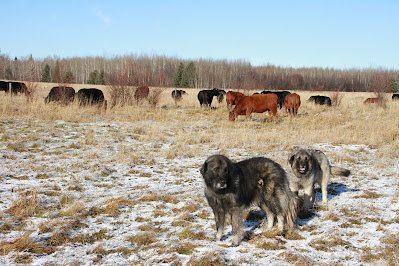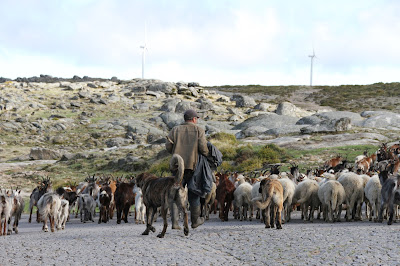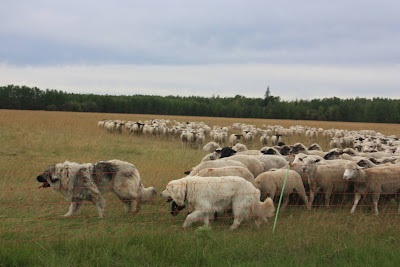 |
| These pups are in the neonatal stage. They can smell and from this early age the smell of their mom, sheep and people becomes imprinted in their brain. |
What is the ideal age to bring a pup home?
©Louise Liebenberg(2021)
Written for : The Shepherds Magazine
Social media platforms always provides me with material to write about! This
past week a man made a post introducing himself and mentioning that he was
excited to welcome his first livestock guardian dog (LGD) puppy to his place
and that he was collecting his 8-week-old pup that week. With that comment, the
floodgate of opinions and advice opened. Most people mentioned that 8 weeks was
“waaaay” too young and that ideally, the pup should remain with its littermates
and mother until at least 12 weeks, but preferably 16 weeks of age. Other
people mentioned even longer, and some said 8 weeks was just fine. I am sure this
first time LGD owner was totally confused what is best to do. I like to give
practical advise and share experiences that will lead to the highest chance of
success for both owner and pup. I like to present what I regard as best practices,
regarding the use of LGD. This discussion on social media led me to change the
original topic I was working on, and I decided to prioritize this one!
The consensus amongst breeders, veterinarians and
behaviorists is that the best age to place a puppy with its new family is
around eight weeks of age. Puppies go through a socialization phase between 7
and 14 weeks. The 8-week age allows the breeder sufficient time to ensure
adequate basic veterinary care that includes deworming and vaccinations and
allows the pup ample time to socialize and form attachments with its new
family. In many States, it is illegal to sell puppies younger than eight weeks
old. This is to ensure that the welfare of the pups is not compromised by
breeders weaning and selling too young. This eight-week-old standard should be
regarded as the absolute minimum age a puppy should leave the litter.
In livestock guardian dogs research, the critical period for bonding the pup to
livestock has also been shown to coincide with that general socialization
phase, researchers suggest that pups can best form a bond to the livestock
between 7 and 16 weeks old. Older dogs can bond to the livestock; however, it
is much easier to utilize this natural socialization phase to encourage bonding
to the livestock.
 |
| This 5-week-old puppy is learning that sheep belong in its world. It is learning to form attachments with the livestock and people, not just to its mother and littermates. |
In the past few years, I have seen a “trend” in many of the online LGD forums advocating for pups to remain longer with the breeder, where some are suggesting that pups should be staying a minimum of 16 weeks with the breeder. I understand the motivation for suggesting this, but the reality is often a lot different. Anyone who has raised a litter of LGD pups will know that by 4 months old, you would have a gang of prepubescent pups who live by their own rules! None of these pups will have had the opportunity to develop individually and few will have had the opportunity to form a close bond with the livestock.
The stress the pup feels when being separated from its littermates is a trigger
for the pup to seek new companions, be it the new family or the livestock. At
four months of age this gang of puppies will be solely focused on each other
and constantly playing/fighting with each other. A large litter will explore
and roam further away and be less motivated to respond to people or the livestock
in a positive way.
If these pups are to be raised around
poultry, a litter of four-month-olds would wreak havoc on these chickens or
even lambs due to playing, roughhousing and general puppy antics. Bad habits
and behaviours can creep in very quickly particularly when the pups feed off
each others excitement. These pups will not be having the ideal start as so
many believe.
 |
| Eight-week-old puppies are very exploratory, provided they have a few littermates to go on adventures together. |
This leads onto the next problem. If someone posts on social
media that they have acquired two pups at the same time, the comment section
fills up with suggestions to separate the pups as possible to ensure they do
not develop littermate syndrome. Littermate syndrome is a term used to describe
when two siblings or close in age pups form a hyper attachment (co-dependency)
to one another, resulting in an inability to function independently, a lack of
forming attachments to people (or livestock) and multiple other behavioural
issues. This co-dependency starts to form during the later stage of the socialization
period, problems may however only be manifested at a later stage, often around
adolescence. It is contradictory to suggest that raising two pups could result
in behavioral issues due to littermate syndrome and yet expect a breeder to
raise a litter until 16 weeks of age!
It is essential that pups need to have time with their littermates to learn
about dog social behaviour, this is where pups learn about fair play, bite inhibition and they learn “dog language”. It is also important for a pup
to observe how the mother interacts with the livestock; a pup that is raised
with livestock will have seen these interactions daily since birth. The
groundwork has been done by the time a pup is 8-12 weeks old. For a young LGD
it is important to learn to function independently, to build confidence, to
learn to work with various dogs and to form attachments to different people and
animals, not just its mother and siblings. This process starts when the pup
leaves the breeder and goes to its new ranch.
Some breeds of dogs are slower maturing than others, a
border collie at 8-weeks old is ready for new adventures, while most LGD pups
are somewhat slower, an 8-week-old Great Pyrenees cannot be compared to an 8-week-old
Border Collie developmentally. Allowing for this, the ideal age for a border
collie to leave the breeder could be 8-10 weeks, while a LGD pup might be
better off leaving at 10 to 12 weeks.
 |
| These pups are 8 weeks old, are learning all about social interactions with other dogs and expanding their learning around the sheep. |
The development of a puppies can be seen as stages. The
stages can be divided up into what the needs of the pup are and its ability to
learn and grow through each period.
These stages are categorized as follows
Neonatal Period (0 – 2 weeks), Transitional Period (2 – 4 weeks), Socialization
Period (3 – 12 weeks), Testing Period (3 – 6 months) and Adolescence (6 – 18
months)
Pups also go through a few fear periods, usually around 8-10 weeks, then 9-14
months and sometimes around 18 months. Fear periods are normal, and it is during
these fear periods that the “fight or flight” instinct becomes established. It
is a mechanism for self preservation, pups need to learn what to be afraid of
and how to avoid bad situations in the future. Coincidently this first fear
period is also right in that optimum socialization period. As a 8 week old pup becomes
more explorative, he will need to learn quickly, what is safe and what is not.
Fear periods can be seen as a crash course in survival training.
 |
| A pup that has been raised with livestock from birth will have the initial foundation, it is for the owner to extend its learning to its new flock. |
So, how does a new owner navigate; optimal canine socialization, introduction
to livestock, littermate syndrome, bonding, fear stages, maturation rate and
attachment issues? I believe it starts with the breeder building that initial
foundation. Ideally, the pup will have had been raised with livestock, has
learnt about canine behaviour from its mom and other littermates and has been
introduced to various sounds and activities on the ranch. Waiting a few weeks
longer until the pup is 10-12 weeks of
age, will give the slower maturing LGD pups a little extra time to learn and
mature. It will most likely have gone through the initial fear stage at the
breeder with nothing bad happening to them at that point. When the pup leaves
to the new owner, there is still sufficient time to start the bonding process
with the new livestock. The separation from its littermates will stimulate its
individual development and it will seek to form new relationships. It is a
valuable time for the new owner to bond the pup with their livestock and
introduce the pup to its new environment. It is important that the new owner
facilitate the pup by providing a safe bonding area with gentle and kind
livestock. Removing a pup too young from the litter can have very negative
consequences for the pup’s development, staying too long at the breeder can
also result in the development of questionable behaviour. To make a long story
short, I believe the best time to bring the new pup home, is around 10 to 12
weeks!












